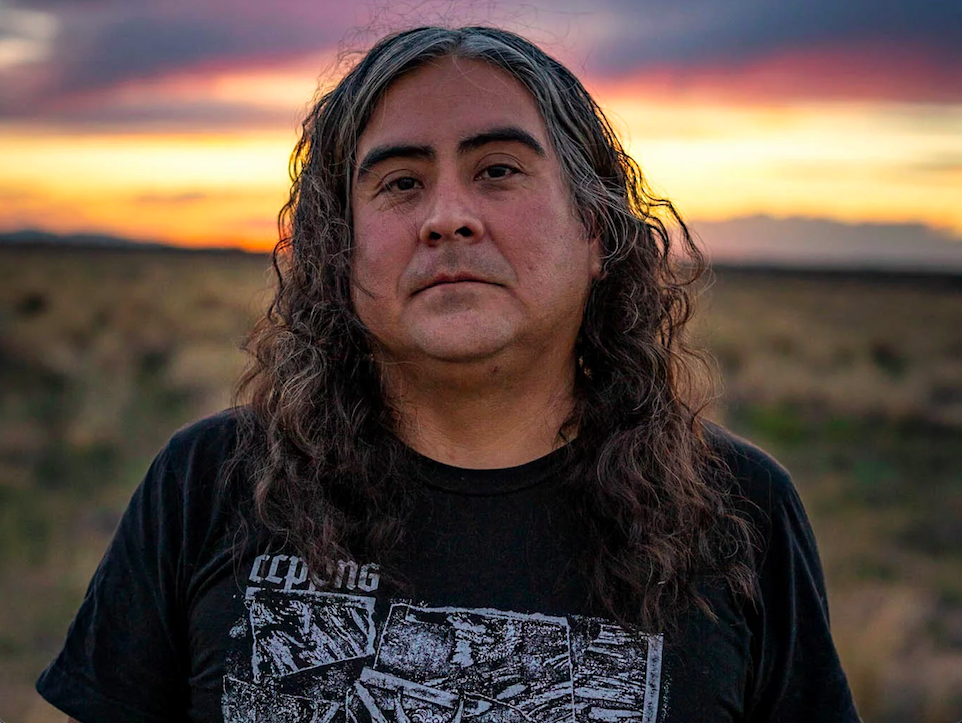
- Details
- By Kaili Berg
Next month, the Harwood Museum of Art in Taos, New Mexico, will open Raven Chacon: Three Songs, an exhibition bringing together three of the artist's projects that pay tribute to Indigenous women through sound, video, and visual arts.
Raven Chacon (Diné) is a composer, performer, and installation artist born in Fort Defiance, Navajo Nation, currently based in Albuquerque, New Mexico. As a solo artist, he has performed at the Los Angeles County Museum of Art, The Kennedy Center, the Heard Museum, and Chaco Canyon. He was awarded the Pulitzer Prize for Music for his piece Voiceless Mass in 2022, becoming the first Indigenous composer to win the prestigious award.
Raven Chacon: Three Songs represents Chacon’s efforts to illuminate the multiplicity of contemporary Indigenous voices, primarily women. Through silence, sound, and language, Chacon uplifts their creativity, which goes into both artistic and political expressions against a backdrop of historic and systemic oppression and its continued present-day manifestations.
Chacon said in a press release that about one-third of his artistic practice is musical composition, one-third is installation and video art, and one-third is improvisational music making, noisemaking, and instrument-building. Of this last category’s activities, Chacon says, “they may be the most freeing of the things I do because those can be opportunities for music to just exist as music.”
Woven through his work is an insightful invitation to perceive aspects of music that exist beyond the sounds notated in Western constructs of music making. In his hands, sound becomes a tool for lining parts of the experience that have been fractured into dissonance. His music is a language of coherence.
“Raven Chacon is one of the most important sound artists working in the United States right now,” Nicole Dial-Kay, Hardwood Museum of Art’s Curator of Exhibitions and Collections, said in a press release.
“He’s an Indigenous artist who is recognized internationally, based here in New Mexico but working across tribal nations. This is the first time that Chacon is showing in Taos, and he is very invested in creating something meaningful for the Taos Pueblo community and the larger Taos community.”
His work will showcase the multi-genre explorations in sound, film, and print, and will run from February 24 through July 7, 2024, at the Harwood.
More Stories Like This
Chickasaw Holiday Art Market Returns to Sulphur on Dec. 6Center for Native Futures Hosts Third Mound Summit on Contemporary Native Arts
Filmmakers Defend ‘You’re No Indian’ After Demand to Halt Screenings
A Native American Heritage Month Playlist You Can Listen to All Year Long
11 Native Actors You Should Know
Help us defend tribal sovereignty.
At Native News Online, our mission is rooted in telling the stories that strengthen sovereignty and uplift Indigenous voices — not just at year’s end, but every single day.
Because of your generosity last year, we were able to keep our reporters on the ground in tribal communities, at national gatherings and in the halls of Congress — covering the issues that matter most to Indian Country: sovereignty, culture, education, health and economic opportunity.
That support sustained us through a tough year in 2025. Now, as we look to the year ahead, we need your help right now to ensure warrior journalism remains strong — reporting that defends tribal sovereignty, amplifies Native truth, and holds power accountable.
 The stakes couldn't be higher. Your support keeps Native voices heard, Native stories told and Native sovereignty defended.
The stakes couldn't be higher. Your support keeps Native voices heard, Native stories told and Native sovereignty defended.
Stand with Warrior Journalism today.
Levi Rickert (Potawatomi), Editor & Publisher

